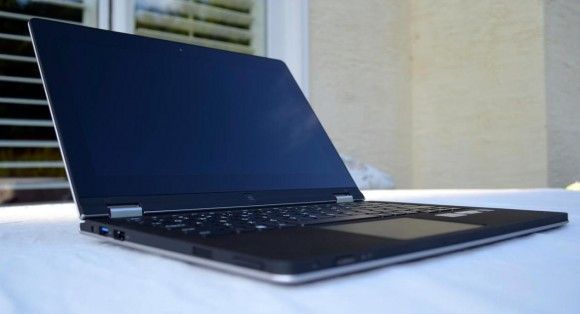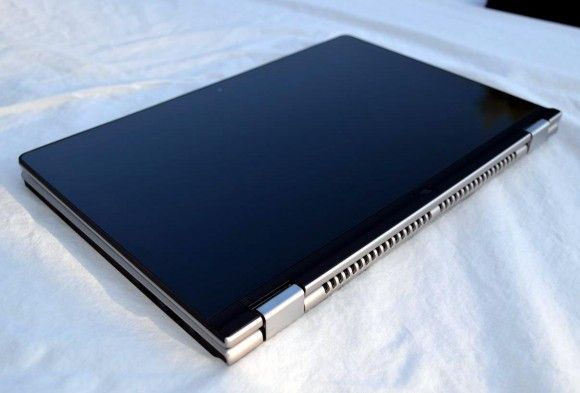The Lenovo Yoga 11S Ultrabook convertible is an 11.6-inch version of the Yoga 13, with one important difference — it’s running an Ivy Bridge ‘1.5’ processor, the Intel Core i7-3689Y. This new processor was created by Intel to meet the demand for small Windows tablets ahead of the Haswell launch. We’ve got the Yoga 11S on hand and will be putting it through the paces over the next few weeks. For now we’ve got our initial impressions and photos for your perusal.
The Ivy Bridge ‘Y’ processors are based on the same architecture as the ‘U’ processors found in most other Ultrabooks, but they’re tuned for a lower max TDP — 13 W vs. 17 W, a 24% decrease in power. Intel also includes a new spec for the Y processor, ‘Scenario Design Power (SDP)’ which they set a 7 W for the Y processors.
Scenario Design Power (SDP) is an additional thermal reference point meant to represent mainstream touch-first usages. It balances performance and mobility across PC and tablet workloads to extend capabilities into thin, thermally-constrained designs.
What this means is that they expect OEMs integrating this product into tablet or convertible style devices should design for 7 W during tablet usage, but the unit is capable of scaling up to 13 W for those high-power desktop scenarios.
What this all means is that we should expect to see better power efficiency over U processors, though battery life may not increase if the OEM decides to use a smaller battery for weight and size considerations. We’ll be sure to check out how the Y processor affect battery life in our full review coming soon.
If you don’t know by now, the Yoga 11S’ convertible trick is that the screen folds all the way back with a patented hinge until you have just the screen on the back. You can see Chippy demonstrate that here with its 13-inch brethren. It’s quick and easy for the most part if the screen is open, but trying to flip it back from completely closed is sort of awkward because there’s no good place to grab it. I’m wishing Lenovo would have left a little thumb notch in place to assist in the initial prying open.
Given that the unit can be had starting at $529 (correction $799), I’m really pleased with the build quality thus far. Most of the unit is made with soft coated plastic materials and I quite like the feel of it. The keyboard deck has what appears at first as a black brushed aluminum, but upon touching it you realize that it’s a soft textured plastic. The word plastic sounds cheap and doesn’t really do justice to the feel — it’s quite satisfying, to me anyway.
The display has excellent viewing angles which great to see as I ran into the opposite with the Gigabyte U2142 which hurt the tablet experience. 1366×768 resolution can be a groan. Some Photoshop work left me wanting much more, though anything above 1600×900 would probably be too high on 11.6-inches. The bezel is pretty wide which can be bothersome, but it turns out to be a necessity for tablet mode — you need a place to grab the unit without touching the screen.
For some reason — maybe it’s the size — the keyboard feels incredibly speedy. Very satisfying.
There’s more testing to come and a detailed account of the unit’s strengths and weaknesses in the coming review. Stay tuned.














What’s the point of the SDP rating if OEMs still need to dissipate the heat specified by TDP? It’s not like SDP is the TDP during some forced low performance setting like cTDP down. So if an OEM actually targets the SDP number without forcing cTDP down or something similar then there’s a chance a person could go beyond the SDP during tablet use which could result in thermal throttling or, even worse, an abrupt forced shutdown.
As for the Yoga, I’m not digging the whole 360 degree screen thing. Seems awkward to use during tablet use plus it’s too big for tablet use anyway I’d rather have a slider type design with a rubber trackpoint in the keyboard.
First, it won’t be operating at its max TDP all the time… In fact it will rarely reach its max TDP and can idle much lower than previous Core i-Processors were capable of reaching…
Second, it can scale in performance and they’re specifically emphasizing where it can go in order to be used in thermally limited designs like tablets.
Basically, Haswell can stick to its SDP most of the time to help control thermals… While a dock, which can boost cooling, can allow it to push its limits when needed.
Like the graphic demo they did showing the 10W Haswell performing a graphical demonstration at around 7W that the equivalent performing Ivy Bridge part was performing at 17W… The take away being that not only could Haswell operate more efficiently but also below its rated TDP and the system could scale itself as needed to meet its thermal requirements, as the same system was also shown operating at a higher performance level but that level could of course be controlled…
Avoiding issues of throttling and forced shutdowns, etc…
The Yoga doesn’t have a dock.
Just like any notebook before the SDP rating was introduced, they usually don’t hit the TDP limit as you’ve said but can. and will at some point. The same can happen with the Yoga so a good manufacturer should still target TDP and not SDP for such a design (ie. no additional cooling docking device).
Scaling the performance down to hit the SDP limit is thermal throttling. So say a user does something that’s resource intensive like a lot of Windows OS updates. If the Yoga’s thermal dissipation design can only dissipate up to the SDP limit then thermal throttling will occur or worse, it’ll shutdown.
@mogo – Yogo doesn’t need a dock because it’s a convertible, but the discussion is about what Intel recommends for designing tablets and not a convertible like the Yogo, which would fall under different design parameters…
Besides, you seem to miss the point that the Y processor is “tuned” for 7W… which means it’s not the same as throttling but a re-optimization of the processor to work well at lower power…
While it’s intended as lower performance offering to begin with, as it’s intended to provide better power efficiency rather than more performance!
Also, Tablets don’t need to work as hard as laptops anyway and even for convertibles… simply keeping the screen off the keyboard, and in a normal laptop position, lets it cool more efficiently!
While Haswell will take it a step further… as Haswell has even better low power state support and optimization… The ULV Haswell also becomes a single chip, MCM… So would be more efficient like a SoC than the higher end two chip versions…
@James
Tuned vs throttled is Intels’s marketing. It really is throttling. Setting the power consumption in relation to TDP is normal performance. Setting it to SDP is the throttled or “tuned” lower performance. There was always a cTDP down throttled setting and Intel introduced an even more throttled setting for the Y chips and called the heat dissipation for this more throttled setting SDP. Not much has really changed and Intel is just spinning thermal throttling as a good thing.
Tablets don’t work as hard as laptops is more that Android, iOS and other limited OS’s can’t do as much as a desktop OS. I certainly would run the exact same things I would on a Windows tablet as I would on a Windows laptop.
Hey,
in Germany that sells for only 899 EUR. This is an equivalent of
1151.62 US Dollar. Let’s all buy that.
Oh wait. Kiss my …
You know, it doesn’t work that way. You can’t compare prices solely on the exchange rate. There are a lot of other more relevant factors when a company decides on a price for a target region.
@Alan yes, indeed, you are right! They take into account where people are used to paying higher prices and keep the prices up accordingly.
They also figure out where they don’t need to compete so hard, cause its not their main volume market.
Hugo sure is right about one thing: Customers don’t really give a rats ass about what “reasons” corporations have to charge more in one place than another, they only have to care about one thing: how much their wallet will get clipped and choose accordingly.
When the difference turns out to actually double the price, we just know that’s politics and not higher transaction costs to europe or better engineered power plugs.
Especially given that laptops usually has a 10-15% price variance between continents, its pretty easy to tell when something is fishy.
Lenovo in particular has sky high price differences in comparison to other computer manufacturers. This is the most ridiculous I’ve ever seen though.
It’s up to the manufacturer to make the SDP so it works just like TDP. That’s how fanless Haswell Tablets are going to be possible.
Also, specifications say that in order for SDP to work, it has to be already in cTDPdown state, which reduces the Base frequency to 800MHz. It can still Turbo, but duration will be limited by cTDPdown’s power limit. If you further cut that down, you have SDP.
In US it costs $799. You can basically say whatever number is in EUR is carried to dollars.
Since there is no dock for this, please check if it’s being throttled down to the 7 W SDP. Also, can you see how long Turbo is maintained? For example, some graphs of time vs frequency during some prolonged load. One for a fully loaded single core and another for all cores.
A hybrid is still a PC and will (at least I would) still run intensive PC tasks. I’m not really interested in the Yoga (I’d prefer a slider with a trackpoint) but with these new Intel chips actual performance during prolonged loads is likely to vary a lot and it’s good to know at what point OEMs start sacrificing performance.
I’d like to also see what thermal targets these Y series based devices have. I’d like to get the thinnest and lightest devices that don’t get throttled down to the 2 cTDP down settings. Even among those I’d try to get the ones that can keep higher Turbos longer.
Me too. These hybrids and tablets are still running full desktop OS’s and I will use the same exact software and do the same exact tasks as on my desktop (ie VMs, large amounts of file compression, software only video encoding, GBs of SSH file transfers, etc.). Time to finish these tasks can vary significantly between a device targeting SDP and one targeting TDP.
Thinness and weight is secondary and I doubt the difference will be that big anyway.
I agree. I’d rather have a thicker device than sacrifice performance because of the cooling needs of somewhat thinner or uselessly thin cases.
Please say whether these devices are throttled to the lower performance. It’s still throttling, just with more control no matter how Intel markets it.
Yes, graphs showing when the Turbo frequencies gets cut back will be useful. I’d like to avoid devices that focus more on thinness than performance and cooling.
Technically, there is a difference between “tuned” versus throttling.
Throttling is when a 17W chip is being used in a 10W chassis. The chassis will run really hot, because the processor will continue try to run at that max frequency.
Also, modern processors have very complex systems to manage power use. Therefore, a 10W chip on a 10W chassis would even run better than 17W throttling to 10W. Controlled versus non-controlled is always in favor of the former.
That’s just a balance between the three:
-Price
-How hot the device gets
-Performance
Obviously even if you are willing to pay enough, there’s limit on cooling technology, so you’ll never be able to get 17W performance on something that’s meant for 1W chips.
Chippy,
the Yoga 11s is starting at $799 in US and 899€ in Europe.
Not $529 (which would be the normal Yoga11 with Tegra CPU)
ah! would indeed be good to fix that in the article…
But even the difference between $799 and $1152 is still quite drastic at over 30%.
They’d better have some other difference in gear level for that much, like a better SSD or more RAM or different CPU.
Or maybe an “I-sponsor-Lenovo” badge to stick on your shirt.
I might order one from the U.S. for my 3 year old once they start to get discounted… She needs something new to chew on. Our mil-spec android handy looks worse for the wear but its still operational!
SDP is stupid IMO.
Here’s a question for Intel.
‘What scenario are you talking about? Are you saying that device with an SDP only works well in one scenario?”‘
SDP is just Intel stamping out versions of a CPU with fixed cTDP configurations (effectively) in order to make it simpler for engineers. They also now have the ability to offer cheaper U-series and therefore lower costs of Ultrabooks. (And lower the performance.)
TDP is just as useless as a figure these days. The terms should never be presented to anyone other than system designers.
I find dynamic range of a platform more important than TDP. Haswell ultrabooks can go from 500mW to 30W drain (1:60 or more)
For scenario power, consumer need to look at detailed battery life reports and ignore “SDP” where no “S” is defined.
Chippy